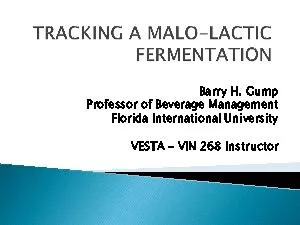

Professor of Beverage Management Florida International University VESTA 150 VIN 268 Instructor MLF easily monitored by paper or thinlayer chromatographic separation absence of a malicacid spot Vi ID: 848996
Download Pdf The PPT/PDF document "Barry H Gump" is the property of its rightful owner. Permission is granted to download and print the materials on this web site for personal, non-commercial use only, and to display it on your personal computer provided you do not modify the materials and that you retain all copyright notices contained in the materials. By downloading content from our website, you accept the terms of this agreement.
1 Barry H. Gump Professor of Beverage Ma
Barry H. Gump Professor of Beverage Management Florida International University VESTA – VIN 268 Instructor MLF easily monitored by paper or thinlayer chromatographic separation absence of a malicacid spot Visual resolution for malicacid limits at approximately 100
2 mg/Lmost winemakers prefer 15 to 30 mg/
mg/Lmost winemakers prefer 15 to 30 mg/L malicacid to consider their wine “safe” WhatmanNo.1 chromatography paperChromatography developing tankSeparatory funnelMicropipettes (20 mL) Wine acid standards (0.3%) purchased as part of kit or made upChromatography solvent can be
3 purchased commercially100 mL nbutanol10
purchased commercially100 mL nbutanol100 mL deionized water10.7 mL stock formic acid15 mL indicator solution prepared by dissolving 1 g of watersoluble bromocresolgreen in 100 mL of deionized water.Shake solvent mixture thoroughly by repeated inversion of separatoryfunnel. Allo
4 w for phase separation, and discard lowe
w for phase separation, and discard lower phase.NOTE!! Solvent should be prepared fresh on a weekly basis. Taking care to handle chromatography paper only by the edges, cut a piece of appropriate size to fit into developing tank.Using a pencil, draw a line parallel to, and approximate
5 ly 2.5 cm from the bottom edge of the pa
ly 2.5 cm from the bottom edge of the paper.Using micropipettes, spot standard acids and wine samples at equal intervals along baseline. Spots should be of as small a diameter as possible (less than 1 cm). Respot at least twice in order to achieve this goal. Each spot should be at lea
6 st 2.53.0 cm apart. A hair dryer can be
st 2.53.0 cm apart. A hair dryer can be used to assist in drying the spots between applications. Transfer solvent to developing tank, allowing at least 30 min for vapor saturation to occur (shake tank). A minimum depth of 0.75 cm of solvent is required for adequate development.Immers
7 e baseline side of paper into tank, taki
e baseline side of paper into tank, taking care that solvent moves uniformly up the paper.When the solvent has ascended to near the upper edge of paper, chromatogram may be removed and allowed to dry.When dry, results may be interpreted by noting the positions of yellow spots (acids)
8 on blue background. Identification of v
on blue background. Identification of various wine acids may be made by comparison to standard acids I. J. T. Baker precoated plastic chromatography sheets with microcrystalline cellulose (J. T. Baker 4480 20x20 cm or equivalent)Chromatography developing tankWine acid standards (
9 0.5%): malic, lactic, and tartaric acids
0.5%): malic, lactic, and tartaric acidsChromatography solvent: In a separatoryfunnel, mix the following:100 mL nbutanol100 mL deionizedwater10 mL stock formic acid0.1 g bromphenolblue indicatorIV. Spot 10 μLstandard acids and wine samples at equal intervals along baseline. Spots
10 should be of as small a diameter as pos
should be of as small a diameter as possible. Let spots dry and respot another 10 μL. A hair dryer can be used to assist in drying the spots between applications Limitations on paper chromatographic method ~ 100 mg/LAvailable kitsProduction of NADHSmall sample volumesNeed to run